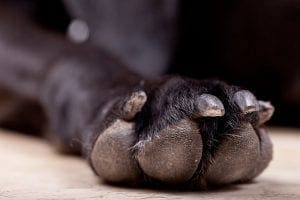Dogs use their paws like humans use their feet. Because of this, it’s important that your dog’s paws are taken care of especially as they age.

The pads of the paw are soft and cushion-like. This is to help protect your dog’s bones and joints from shock, and also to protect during extreme conditions and rough terrain. But like the bottoms of human feet, paw pads are not built to withstand everything they come into contact with and deteriorate with age.
So that your dog can maintain optimum mobility and confidence regardless of age or any special needs they may have, it’s imperative to care for your dog’s paw pads.
Here we offer some tips to keep your dog’s paws healthy:
1. Keep Nails Trimmed
Trimmed nails on your dog’s paws help them stay clean and walk comfortably. If you can hear the nails clicking on hard surfaces when your dog walks, it’s time for a trim. Many dog owners find the task of trimming their dog’s nails difficult or overwhelming, and in this case, it’s best to take your dog to a vet or a groomer.
2. Keep Hair on Paws Short
Grooming the hair on your dog’s paws prevents matting. It’s especially important to trim the hair between the paw pads so your dog doesn’t slip on its own fur. Ideally, the hair should be cut even with the paw pads.
3. Moisturize Paw Pads
Just like human hands and feet, paw pads can get dry and cracked– especially in the winter. But it’s not a good idea to use human lotions on dogs, so we advise you to speak to your vet about the best paw moisturizer.
4. Paw Massages
Even our pets get tension! A good way to care for your dog’s paws is to give them a little rub. The sweet massage spots on dog paws are between the toes and right on the paw pads. A quick paw massage every once and a while will get the blood flowing in your dog’s paws.
5. Keep an Eye Out for Foreign Objects
It’s easy for small objects to get lodged in your pet’s paw pads. Be aware when your dog is trying to stay off a certain paw or when they appear distressed that there could likely be something stuck in their paw. Splinters, broken glass, pebbles, or other small objects are common culprits.
6. Take Care of Cuts
Whether from a foreign object, a misstep, or something else, sometimes dogs end up with cuts or scrapes on their paws. If the cut that is smaller than a half inch, you can take care of it at home with antibiotic wash and a loose bandage. Consult your vet if the cut is larger than a half inch.
7. Avoid Summer Paw Pad Burns
Walking on hot pavement or sand in the summertime can cause the paw pads to burn. Try to avoid these surfaces, but if your pet does burn its paw, you can treat it the same way as a cut.
8. Avoid Winter Ice Melting Chemicals
While cold weather can dry out and crack your dog’s paws, a more serious risk is the chemicals we use to melt ice. These chemicals can be toxic if your pet ends up with some on its paws then licks the paws. Avoid this situation by washing your dog’s paws with warm water after coming in from outside when salt or chemicals have been used recently. Or you can coat the paw pads in Vaseline prior to going outside.
9. Use PawFriction If Your Pet Needs Extra Traction
For senior pets and dogs with special needs, PawFriction is a great option for helping them regain necessary paw pad traction. The application is simple, safe, and helps your dog stay healthy and confident!
Shop PawFriction now to learn more about getting your dog back to the paw traction he or she needs.
